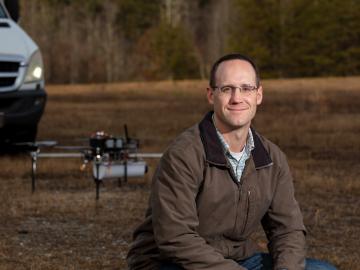
Filter News
Area of Research
- (-) National Security (17)
- (-) Neutron Science (19)
- (-) Supercomputing (60)
- Advanced Manufacturing (8)
- Biology and Environment (21)
- Building Technologies (1)
- Computational Engineering (3)
- Computer Science (12)
- Energy Science (63)
- Fusion and Fission (7)
- Fusion Energy (8)
- Isotope Development and Production (1)
- Isotopes (10)
- Materials (83)
- Materials Characterization (2)
- Materials for Computing (14)
- Materials Under Extremes (1)
- Mathematics (1)
- Nuclear Science and Technology (12)
- Nuclear Systems Modeling, Simulation and Validation (1)
- Quantum information Science (4)
News Type
News Topics
- (-) Advanced Reactors (2)
- (-) Composites (1)
- (-) Computer Science (53)
- (-) Cybersecurity (14)
- (-) Isotopes (1)
- (-) Materials (17)
- (-) Microscopy (6)
- (-) Polymers (2)
- (-) Space Exploration (3)
- 3-D Printing/Advanced Manufacturing (7)
- Artificial Intelligence (20)
- Big Data (7)
- Bioenergy (9)
- Biology (8)
- Biomedical (14)
- Biotechnology (1)
- Buildings (1)
- Chemical Sciences (5)
- Coronavirus (11)
- Critical Materials (3)
- Energy Storage (11)
- Environment (11)
- Exascale Computing (8)
- Frontier (14)
- Fusion (3)
- Grid (6)
- High-Performance Computing (15)
- Machine Learning (9)
- Materials Science (19)
- Molten Salt (1)
- Nanotechnology (12)
- National Security (11)
- Neutron Science (63)
- Nuclear Energy (5)
- Partnerships (4)
- Physics (13)
- Quantum Computing (9)
- Quantum Science (17)
- Security (8)
- Simulation (2)
- Summit (20)
- Transportation (7)
Media Contacts

The U.S. Department of Energy’s Innovative and Novel Computational Impact on Theory and Experiment, or INCITE, program is seeking proposals for high-impact, computationally intensive research campaigns in a broad array of science, engineering and computer science domains.

Using complementary computing calculations and neutron scattering techniques, researchers from the Department of Energy’s Oak Ridge and Lawrence Berkeley national laboratories and the University of California, Berkeley, discovered the existence of an elusive type of spin dynamics in a quantum mechanical system.

To better understand the spread of SARS-CoV-2, the virus that causes COVID-19, Oak Ridge National Laboratory researchers have harnessed the power of supercomputers to accurately model the spike protein that binds the novel coronavirus to a human cell receptor.

Six scientists at the Department of Energy’s Oak Ridge National Laboratory were named Battelle Distinguished Inventors, in recognition of obtaining 14 or more patents during their careers at the lab.

Six ORNL scientists have been elected as fellows to the American Association for the Advancement of Science, or AAAS.

The annual Director's Awards recognized four individuals and teams including awards for leadership in quantum simulation development and application on high-performance computing platforms, and revolutionary advancements in the area of microbial

Scientists from Oak Ridge National Laboratory used high-performance computing to create protein models that helped reveal how the outer membrane is tethered to the cell membrane in certain bacteria.

Researchers at ORNL used quantum optics to advance state-of-the-art microscopy and illuminate a path to detecting material properties with greater sensitivity than is possible with traditional tools.

Oak Ridge National Laboratory scientists have discovered a cost-effective way to significantly improve the mechanical performance of common polymer nanocomposite materials.

Horizon31, LLC has exclusively licensed a novel communication system that allows users to reliably operate unmanned vehicles such as drones from anywhere in the world using only an internet connection.


